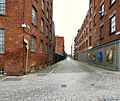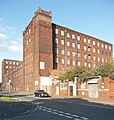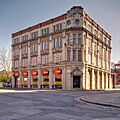List of mills in Manchester facts for kids
This article lists some of the important cotton and textile mills that once operated in Manchester, England. These mills were like big factories where raw cotton or other materials were spun into yarn and then woven into fabric. Manchester was a very important city during the Industrial Revolution because of these mills, earning it the nickname "Cottonopolis."
Contents
- Famous Mills of Manchester
- Albion Mill
- Beehive Mill
- Bengal Street Block
- Brownsfield Mill
- Brunswick Mill
- Cambridge Street India Rubber Works
- Chatham Mill
- Chorlton Mills Complex
- Crusader Works
- Hope Mill
- Little Mill
- McConnel and Kennedy Mills Complex
- Murrays' Mills Complex
- Newton Silk Mill
- Piccadilly Mill
- Shudehill Mill
- Victoria Mill
- Images for kids
- See also
Famous Mills of Manchester
Albion Mill
The Albion Mill was located on Pollard Street in Ancoats. It was an important textile mill in its time.
Beehive Mill
The Beehive Mill on Jersey Street in Ancoats was built around 1824. It was known as a "Room and Power" mill, which meant it rented out space and power (from its steam engine) to smaller businesses. By 1891, a company called B. and I. Wild operated 12,000 spindles there, which are machines used for spinning yarn.
Bengal Street Block
This building was an extension of the Beehive Mill, added in 1848. It was partly rebuilt in 1861 after a fire. In 1891, it worked with Union Mill and had 16,000 spindles. Sadly, it was destroyed by fire in 2005.
Brownsfield Mill
Located on Binns Place, the Brownsfield Mill was built around 1825. It was also a "Room and Power" mill, meaning it provided space and power for different businesses. It was a large, L-shaped building with seven floors. Later, in 1910, a famous company called AV Roe (which became Avro) started making airplanes there!
Brunswick Mill
The Brunswick Mill was built in 1840 on Bradford Road in Ancoats, right next to the Ashton Canal. It was a huge mill with seven floors and 35 sections facing the canal. It was built by David Bellhouse. In the 1850s, it had a massive 276 carding machines and 77,000 mule spindles, showing how much yarn it could produce. By 1891, it still had 73,000 spindles.
Cambridge Street India Rubber Works
This unique mill on Cambridge Street in Chorlton-on-Medlock was owned by Charles Macintosh & Company. They were famous for making rubberized waterproof fabrics. In fact, their product was so popular that the word "mackintosh" became a common term for a waterproof overcoat!
Chatham Mill
Also known as Runcorn's Mill, the Chatham Mill was built in 1820 on Chester Street. It had six floors and an attached warehouse. The mill had wooden floors, but the warehouse was built with strong iron columns.
Chorlton Mills Complex
The Chorlton Mill complex in Chorlton-on-Medlock was a group of mills, including Chorlton Old Mill, Chorlton New Mill, and Marsland Mill. Much of this area is now part of the Manchester Metropolitan University.
Chorlton New Mill
The Chorlton New Mill was built in 1813 and expanded in 1818 and 1845. It was used for spinning cotton and later for processing rubber. It was connected to Charles Macintosh, who made waterproof cloth nearby.
Chorlton Old Mill
The Chorlton Old Mill, also called Cambridge Mill, had an earlier version built in 1795 and managed by Robert Owen, a famous social reformer. It was greatly expanded around 1810 and then mostly rebuilt in 1866. It was later turned into homes in 1993.
Crusader Works
The Crusader Works, also known as Chapeltown Street Mill, was built in the mid-19th century. It was first used for spinning, then for making machines, and later as a clothing factory. More recently, it was home to art studios and other businesses before being bought for redevelopment into apartments.
Hope Mill
The Hope Mill on Pollard Street in Ancoats was built in 1824 for Joseph Clarke and Sons. It was later owned by John Jackson Junior, who had 2,000 spindles. In the 20th century, it was used by John Hetherington and Sons, who made textile machines.
Little Mill
Part of the large Murray Mills complex on Jersey Street in Ancoats, the Little Mill was rebuilt in 1908. It's special because it was one of the very first mills in Greater Manchester to use mains electricity as its main power source!
McConnel and Kennedy Mills Complex
This was a huge group of mills on Redhill Street in Ancoats, including Royal Mill, Sedgewick Mill, and Paragon Mill.
Royal Mill
The Royal Mill was originally called the New Old Mill and was built in 1912. It was renamed Royal Mill after King George visited on November 19, 1942. It is part of the McConnel and Kennedy Mills complex.
Sedgwick Mill
The Sedgwick Mill was built in 1818 and was designed by James Lowe. It was an eight-story building with 17 sections. It was also part of the McConnel and Kennedy Mills complex.
Paragon Mill
Built in 1912, the Paragon Mill was also part of the McConnel and Kennedy Mills complex. It was an eight-story building and was considered the world's tallest cast-iron structure when it was built! In 1835, a French writer named Alexis de Tocqueville visited the Redhill Street Mill (part of this complex) and described how 1,500 workers, mostly women and children, worked 69 hours a week. By 1891, McConnel and Co. had 130,000 spindles across their mills.
Murrays' Mills Complex
This was another large group of mills on Murray Street in Ancoats, including Old Mill, Decker Mill, New Mill, Murray Street Block, Doubling/Fireproof Mill, and Little Mill.
Old Mill
The Old Mill on Redhill Street in Ancoats was built in 1798. It was part of the Murrays' Mills complex. It was a very important mill, and by 1891, A. and G. Murray Limited had 100,000 spindles across their mills.
Decker Mill
The Decker Mill was built in 1801 and was also part of the Murrays' Mills complex.
New Mill
The New Mill on Jersey Street was built in 1804 and was another part of the Murrays' Mills complex.
Waulk Mill
Also known as Doubling Mill or Fireproof Mill, the Waulk Mill was built in 1842 and was part of the Murrays' Mills complex.
Newton Silk Mill
Located on Holyoak Street in Newton Heath, the Newton Silk Mill was built in 1832. Even though it was a silk mill, it shows the variety of textiles produced in Manchester. Today, it has been converted into office spaces.
Piccadilly Mill
Also called Drinkwater's Mill, the Piccadilly Mill was built in the late 1780s by Peter Drinkwater. It was managed by Robert Owen in the 1790s. This cotton mill was very important because it was the first in Manchester to use a stationary steam engine made by the famous engineers Boulton and Watt.
Shudehill Mill
The Shudehill Mill was built in 1782. Sadly, it was destroyed by bombing in 1940 during World War II.
Victoria Mill
The Victoria Mill was built in 1867 and 1873 on Lower Vickers Street in Miles Platting, right next to the Rochdale Canal. It was designed by George Woodhouse and was a "double mill" with a shared engine house and an octagonal chimney. In 1891, it had an impressive 170,000 spindles. It continued to operate until the 1960s and has since been turned into offices and homes.
Images for kids
See also
- List of warehouses in Manchester





























